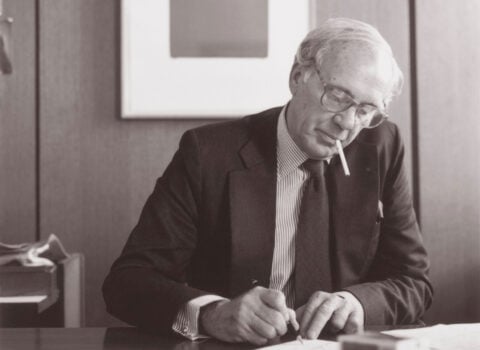Say No to Dubai on the Hudson
“Pharaonic exclusion is their motto; contempt for human scale and ordinary people their raison d’être.”
West 57th Street in Manhattan might seem an unlikely setting for Mayor Bill de Blasio’s “tale of two cities.” After all, no poor people live there (unless they’re sleeping in doorways).
However, the announcement last month that the Rizzoli bookstore at 31 W. 57th would close — to make way for yet another luxury tower — has caused me to see the neighborhood in a different light. It might be just the place for the new mayor to draw the line in the battle between the global plutocracy and everybody else.
Anyone traversing 57th Street will probably notice the famous Carnegie Hall, at the corner of 7th Avenue; Bergdorf Goodman, the fancy department store, on the corner of Fifth Avenue; and Steinway Hall, the landmarked piano showroom, at 109 W. 57th.
Easy to overlook is Rizzoli, smallish and unassuming but nonetheless a cultural jewel that in some respects is as important to the city’s social fabric as are its better-known neighbors. Perusing the three floors of Rizzoli affords an intellectual comfort and stimulation that is rapidly disappearing — along with bookstores themselves — in decreasingly cosmopolitan Manhattan.
All those tables covered with beautiful volumes of art and photography; all those lovely bookcases filled with English, French, and Italian literature — this is the culture-rich New York that used to be accessible in discreet and intimate locations all over town. With its vaulted ceilings, thick carpets, and wood paneling, Rizzoli is unmistakably elegant, but that doesn’t make it any less democratic, since you don’t have to pay a cent to get in the door.
The same cannot be said of the grotesquely oversized “residential” high-rises springing up along 57th Street and elsewhere in New York. Pharaonic exclusion is their motto; contempt for human scale and ordinary people their raison d’être. During Hurricane Sandy, the whole world was able to watch a crane dangling dangerously from the 75th floor of 157 W. 57th and wonder at the shortsighted greed of real-estate developers and their friends in city government. The question wasn’t, as one reporter posed it to former mayor Michael Bloomberg, whether the crane operator was properly licensed by the city. The question was why Bloomberg and the Department of City Planning had permitted the tower to be constructed in the first place.
The answer lies in the price per square foot — on average more than $6,000 a square foot for a condominium in 157 W. 57th. Real-estate money — from sellers and buyers alike — is catnip for politicians and bureaucrats hungry for tax revenue . . . and campaign contributions.
Now smaller buildings along the street are toppling like dominos. The vacant lot at 111 W. 57th, next to Steinway Hall, will before long be occupied by an apartment building that resembles a misshapen needle, seventy-seven stories and just sixty feet wide. Whatever replaces the six-story structure that houses Rizzoli, and two adjacent properties also slated for demolition, it surely won’t be low-rise public housing. Bloomberg’s fellow billionaires, be they Russian, Chinese, or Saudi, will be grateful for their spectacular views of Central Park.
Is there any hope for Rizzoli? Employees of the bookstore have collected more than 10,000 signatures protesting the demolition plan, and the local community board has written Robert Tierney, chairman of New York’s Landmarks Preservation Commission, calling for public hearings. But this is more than an uphill battle — in New York, only Spider-Man can scale the face of a skyscraper, or challenge a real-estate mogul.
Rizzoli’s home — the former Sohmer Piano Co. showroom, built in 1919 in French classical style — is already shrouded in black netting, so it’s no longer possible to view the store’s lovely exterior. Seasoned smashers of all things bright and beautiful, the owners, the LeFrak family and Vornado Realty Trust, have covered up their pre-emptive defacement of the façade. The balustrade over the arched entrance was recently removed, no doubt to diminish the building’s architectural significance and discourage Tierney from reconsidering his staff’s rejection of pleas to save it.
I asked Peg Breen, president of the private New York Landmarks Conservancy, if she thought the new mayor might intervene. “I’m not hopeful,” she told me. “REBNY [the Real Estate Board of New York] is the only entity with a loud voice.” And de Blasio has so far disappointed her on zoning and preservation issues. “When he was first elected public advocate, he was very friendly and even came to our board meetings,” Breen said. “Since then, nothing. [Preservation] certainly wasn’t part of his campaign.”
Of course, de Blasio (whose office has not responded to my repeated queries) could justifiably argue that he has bigger fish to fry and smaller fry to protect than a pretty bookstore owned by an Italian corporation. But time is of the essence for Manhattan, where the money power is truly out of control. You don’t need to be down and out to feel crowded out by apartments costing $90 million.
Why not make a stand on 57th Street — before our city turns into Dubai-on-the-Hudson?




